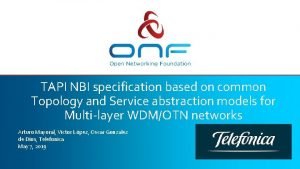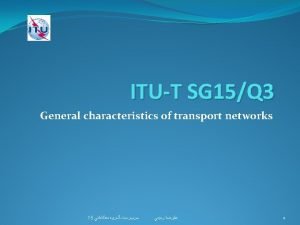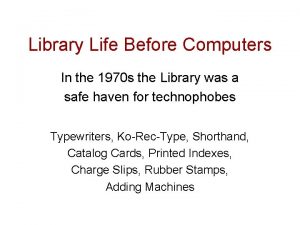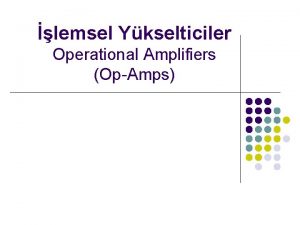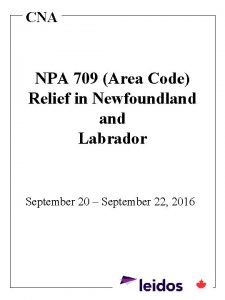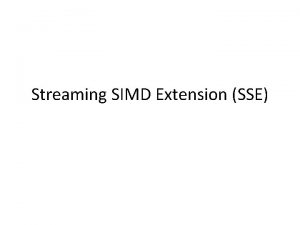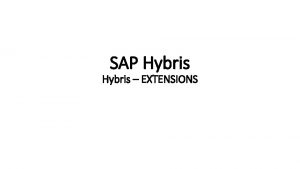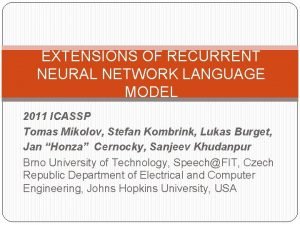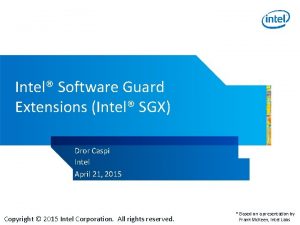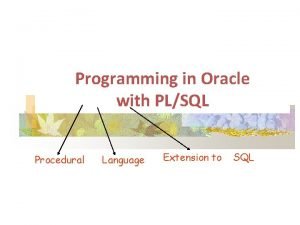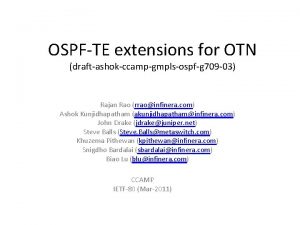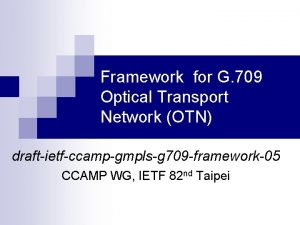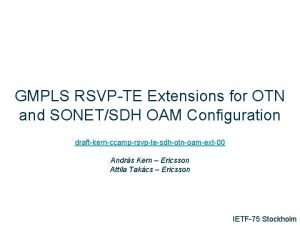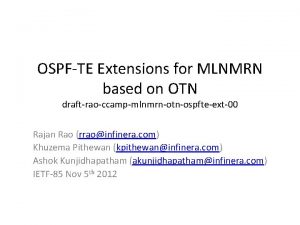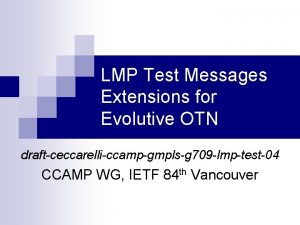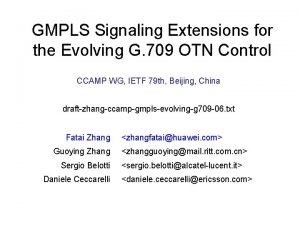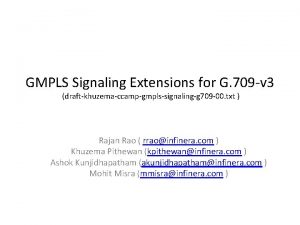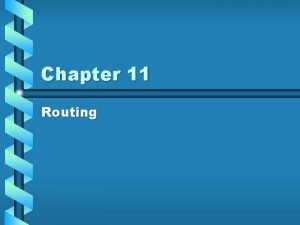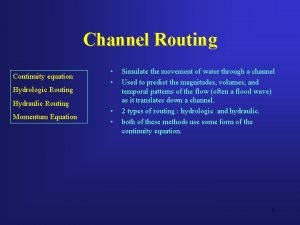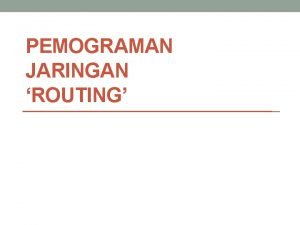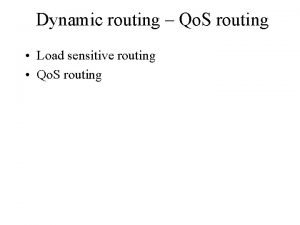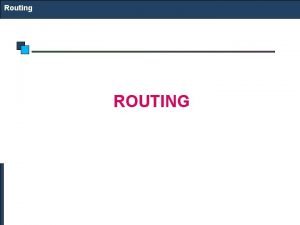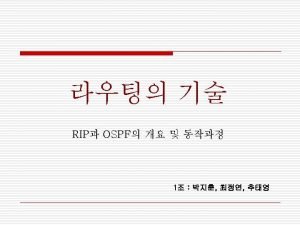Routing Extensions for G 709 OTN draftashokccampgmplsospfg 709
























- Slides: 24

Routing Extensions for G. 709 OTN (draft-ashok-ccamp-gmpls-ospf-g 709 -02. txt) Rajan Rao (rrao@infinera. com) Ashok Kunjidhapatham (akunjidhapatham@infinera. com) Khuzema Pithewan (kpithewan@infinera. com) Snigdho Bardalai (sbardalai@infinera. com) 1

Outline • • • Goals Proposal Discussion items Advantages & Comparison Backup 2

Goals A generic, scalable BW model that: – covers all OTN services including ODUflex, – covers potential evolution of OTN standards, – Hides complexities of TS disparities, – is Backwards compatible (to RFC 4203), – supports G. 709 -v 3 complete muxing hierarchy, – is ready for VCAT services 3

Proposal • Simple extensions to RFC-4202 – Retains main ISCD format • Consistent with RFC-4202, RFC-4203 & RFC-4201 – Switching type =TDM & Encoding type = ODUk – Max LSP BW in bytes/sec • Technology specific extensions in SCSI – Expands SCSI to carry G. 709 -v 3 BW info • Advertise #of ODU containers for fixed rate ODUs • Advertise ODUflex BW in bytes/sec • Per Signal Type BW coverage – for Max-LSP & Unreserved BW types • Coverage for complete muxing hierarchy (G. 709 -v 3) 4

Proposal: ISCD & SCSI formats 5

Proposal: SCSI format (ODUflex) 6

Example – Muxing Hierarchy Coverage ST BW Type Available ODUs at priority Pi ODU 4 (4) 0 (Max-Lsp-Bw ) 1 ODU 3 (3) 0 (Max-Lsp-Bw ) 2 ODU 0 (5) 0 (Max-Lsp-Bw ) 82 ODUflex(10) 0 (Max-Lsp-Bw) ( 80 x 1, 301, 709 )/8 bytes/sec ODUflex(10) 2 (Min-Lsp-Bw) 1, 301, 709 /8 bytes/sec 7

Discussion Items (1) 1. Question-1: Use of ISCD: : Max-LSP-BW results in path computation failure when ODUflex is not supported (Danielle’s comment) Authors agreed to the issue raised Resolved by moving ODUflex BW advertisement to SCSI Updated draft was sent out 10/28/10 – – – 2. Question-2: Value for ISCD: : TDM: Minimum-LSP-BW field (Pietro’s comment) Authors agreed to the issue raised – • Previously this field was used for ODUflex. With ODUflex moved to SCSI this is not the case. There is no issue in setting the value to lowest switchable container. Clarification will be provided in next draft update – – 3. The value is not restricted to TSG = {1. 25, 2. 5}. It is lowest switchable container Question-3: No backwards compatibility issues as no ODU adv defined in RFC 4202/4203/4328 (Danielle’s comment) Authors believe backwards compatibility with G. 709 -v 1 is required to comply with the above RFCs The solution proposed addresses backwards compatibility fully (ref draft-ashok-02) If WG agrees to not support backwards compatibility, we could use main ISCD for ODUflex – – – • ref to backup slides 15 -17 for details 8

Discussion Items (2) 4. Question-4: Full muxing not a requirement (Fatai’s comment) – – – Authors didn’t agreed to the comment Our interpretation of G. 709 -v 3 is full hierarchy support is required We agree with Deborah’s comments on NOT restricting GMPLS solution to a single stage 9

Advantages & Comparison Advantages: • • • Re-using of existing ISCD definitions (RFC 4202) Technology specific extensions consistent with GMPLS arch Backwards compatible with G. 709 -v 1 (RFC 4202, RFC 4203, RFC 4328) – without the use of multiple ISCDs • • Coverage for complete muxing hierarchy (G. 7090 -v 3 ) Doesn’t require MLN to address muxing hierarchy Doesn’t prevent MLN deployments More compact encoding Comparison: • Not clear why we need a new technology agnostic ISCD for GMPLS as proposed by other draft – Creating a new ISCD will cause backwards compatibility issues for existing GMPLS/MPLS-TP deployments (e. g. PSC, SONET/SDH, LSC) • • Requires MLN to support muxing hierarchy Don’t agree with Termination/Switching capability advertisement 10

BACKUP SLIDES 11

Comparison (1) Draft-Ashok Draft-Ceccarelli Model • Simple extensions to RFC 4202 • Consistent with GMPLS model • Technology specific extensions in SCSI • New BA similar to ISCD already defined Hierarchy Handling • Full mux capability taken care • No FA-LSPs required to address G. 709 -v 3 mux layers • Smaller TE-DB & Scalable • Addresses only one level • Requires Te-Link per Mux layer to support G. 709 -v 3 hierarchy • Not a scalable solution Backward Compatibility Compatible with G. 709 -v 1 deployments (RFC-4202/4203/4328) Redefines G. 709 ISCD. Invalidates RFC 4328. In general breaks away from existing GMPLS model for BW advertisement. Scalable Model • Compact sub-TLVs defined • Further optimization possibilities with priority bit-map use • Easy to deal with future extensions • Service. Type repeated per priority per signal type • use of 4 words unnecessary for advertising #of ODU containers • Future extensions may force having SCSI in BA (duplication of 4202 ISCD) 12

Comparison (2) Draft-Ashok Draft-Ceccarelli Termination & Switching flags • Don’t see the need • Not supported • supported VCAT Addressed using BW-Type=1 advertisement Not addressed Size Compact 1) OTU 4 link with 7 signal types + 8 1) 59 words priorities 2) OTU 4 link with 7 2) 50 words signal types + 5 priorities Numbers are higher than draftashok model 1) 114 words Simplicity The unit of BW depends on M field. Depending on the value of M field, BW could be interpreted as simple unsigned integer or IEEE floating point number. Results in engineering complexity 13 Simple TLV structure, easy to encode/decode. 2) 70 words

ISCD Size Comparison for an OTU 4 Link Draft-Ashok Draft-Ceccarelli Number of Priority Levels Supported 8 8 5 3 ODU 4 6 16 10 6 ODU 3 6 16 10 6 ODU 2 e ODU 2_ANY ODU 1 ODU 0 ODUflex Total Variable Total Fixed Total ISCD Size(in words) 6 6 6 10 40 12 16 16 - 16 16 32 128 1 10 10 20 80 1 6 6 12 48 1 52 129 81 49 Note: 1. Draft-Ashok uses signal type of ODU 2_ANY for {ODU 2 & ODU 2 e} 2. All units are in number of words (4 bytes). 14

Backwards Compatibility (1) Node-A Node-B Node-C Link A-B: – G. 709 -v 1 version compatible OTUk interface (2001) – Uses RFC 4328 for signaling – RFC 4203 & RFC 4201 based ISCD interpretation Link B-C: – G. 709 -v 3 version compatible OTUk interface (12/09) – Uses ISCD + SCSI extensions as per our draft 15

Backwards compatibility(2) Link A-B (G. 709 -v 1 Telink RF C 4203/4201) Link B-C (G. 709 -v 3 Telink based on our draft) Old CSPF Compatible ( Ref to Note below) New CSPF Compatible Note: • The GOAL is to make TE-links with newer OTN capabilities compatible with CSPF in deployed networks • The ISCD format proposed in our draft allows Node-A – To interpret un. Reserved-BW, Max. LSP-BW and Min. LSP-BW as per RFC 4203 & RFC 4201 • Crank-back possibilities if muxing limitations exist – With or without Node-A going through software upgrade • Our BW model extended to support ODUflex – ODUflex a separate sub-TLV in SCSI – Addresses the case when ODUflex is not supported (the scenario highlighted in Daniele’s email) 16

Options to address Backwards Compatibility 1. If backwards compatibility needs to be addressed: – Use main ISCD as per RFC 4202/4203/4201 – New sub-TLV for ODUflex in SCSI (BW in bytes/sec) 2. If backwards compatibility is not an issue: – Use main ISCD for ODUflex BW advertisement – No need for a separate sub-TLV for ODUflex • Either option can be easily accommodated in our BW Model – Option#1 is preferred approach 17

OTN example • The example below will be used where: – TE-link#1 is a link of type OTU 2 supporting timeslot granularity of 2. 5 G – TE-link#2 is ODU 1 supporting time-slot granularity of 1. 25 G – TE-link#3 is a link of type OTU 2 supporting timeslot granularity of 1. 25 G ODU 0 Service TE-link#2 TE-link#3 TE-link#1 18

OTN example – first level • The advertisement for TE-link#1 (OTU 2 with TS=2. 5 Gbps) would be: – – – • Available ODU 2 s @Pi : 1 Available ODU 1 s @Pi : 4 Available ODU 0 s @Pi : 0 (not supported on this link, not included in the adv) Max-LSP-BW = 10 Gpbs Min-LSP-BW = 2. 5 Gbps (ODU 1 nominal rate) The advertisement for TE-link#3 (OTU 2 with TS=1. 25 Gbps) would be: – – – Available ODU 2 s @Pi : 1 Available ODU 1 s @Pi : 4 Available ODU 0 s @Pi : 8 (supported on this link) Max-LSP-BW = 10 Gpbs Min-LSP-BW = 1. 25 Gbps (ODU 0 nominal rate) TE-link#3 TE-link#1 19

OTN example – second level • The advertisement for TE-link#2 (ODU 1 FA-LSP) is: – – – • Available ODU 2 s @Pi : 0 (not included in the adv) Available ODU 1 s @Pi : 1 Available ODU 0 s @Pi : 2 (supported on this link) Max-LSP-BW = 2. 5 Gpbs Min-LSP-BW = 1. 25 Gbps (ODU 0 nominal rate) The advertisement for TE-link#1 (OTU 2) changes to: – – – Available ODU 2 s @Pi : 0 (not included in the adv) Available ODU 1 s @Pi : 3 Available ODU 0 s @Pi : 0 (not supported on this link, not included in the adv) Max-LSP-BW = 7. 5 Gpbs Min-LSP-BW = 2. 5 Gbps (ODU 1 nominal rate) TE-link#2 TE-link#3 TE-link#1 20

OTN example – third level • • Establish ODU 0 service. The advertisement for TE-link#2 (ODU 1) changes to: – – – • Available ODU 2 s @Pi : 0 (not included in the adv) Available ODU 1 s @Pi : 0 (not included in the adv) Available ODU 0 s @Pi : 1 Max-LSP-BW = 1. 25 Gpbs Min-LSP-BW = 1. 25 Gbps (ODU 0 nominal rate) The advertisement for TE-link#3 (OTU 2) changes to: – – – Available ODU 2 s @Pi : 0 (not included in the adv) Available ODU 1 s @Pi : 3 Available ODU 0 s @Pi : 7 Max-LSP-BW = 8. 75 Gpbs Min-LSP-BW = 1. 25 Gbps (ODU 0 nominal rate) ODU 0 service TE-link#2 TE-link#3 TE-link#1 21

OTN example – Bundled links • • Say TE-link#3 is a bundle of 3 x. OTU 2 s The advertisement for TE-link#3 before ODU 0 service is added: – – – • Available ODU 2 s @Pi : 3 Available ODU 1 s @Pi : 12 Available ODU 0 s @Pi : 24 Max-LSP-BW = 10. 0 Gpbs Min-LSP-BW =1. 25 Gbps (ODU 0 nominal rate) The advertisement for TE-link#3 after ODU 0 service is added: – – – Available ODU 2 s @Pi : 2 Available ODU 1 s @Pi : 11 Available ODU 0 s @Pi : 23 Max-LSP-BW = 10. 0 Gpbs Min-LSP-BW =1. 25 Gbps (ODU 0 nominal rate) ODU 0 Service TE-link#2 TE-link#3 TE-link#1 22

OTN example – ODUflex • • Add ODUflex connection of 5. 0 Gbps on TE-link#1 The advertisement for TE-link#1 (OTU 2) changes to: – Available ODU 2 s @Pi : 0 (not included in the adv) – Available ODU 1 s @Pi : 1 – Available ODU 0 s @Pi : 0 (not supported & not included in the adv) – SCSI: : ODUflex: Max-LSP-BW = 2. 5 Gpbs (used for ODUflex) – SCSI: : ODUflex: Min-LSP-BW = 2. 5 Gbps (ODU 1 nominal rate used for ODUflex) TE-link#3 TE-link#1 23

Issue with RFC 4201 Bundled Link with 5 component links, each with OTU 2 rate and supports the following muxing capabilities: ODU 2/ODU 0 ODU 2/ODU 1/ODU 0 1. BW before any service is created Unreserved BW = 50 Gbps, Max-LSP-BW = 10 G (ODU 2), Min-LSP-BW = 1. 25 G (ODU 0) 2. BW After creating four ODU 0 service and each using separate component link in the bundled link Unreserved BW = ~45 Gbps, Max-LSP-BW = 10 G (ODU 2), Min-LSP-BW = 1. 25 G (ODU 0) 3. The issue after step #2: A node computing ODU 2 -4 v path for a 40 G client would select this link if per layer BW information is not available; results in a crank back. 24
 Otn
Otn Otn medical abbreviation
Otn medical abbreviation Continuity equation hydrology
Continuity equation hydrology Power routing in vlsi
Power routing in vlsi Difference between reservoir routing and channel routing
Difference between reservoir routing and channel routing Mark tinka
Mark tinka Acordada 961/15
Acordada 961/15 Google matps
Google matps Sample completed irs form 709 2020
Sample completed irs form 709 2020 çarpmada integral alma
çarpmada integral alma 709 area code
709 area code O homem que calculava malba tahan
O homem que calculava malba tahan Vc 709
Vc 709 Streaming simd extensions
Streaming simd extensions Sap commerce extensions
Sap commerce extensions Git flow branching strategy
Git flow branching strategy Mapping extensions
Mapping extensions Extensions of recurrent neural network language model
Extensions of recurrent neural network language model Introducing and naming new products and brand extensions
Introducing and naming new products and brand extensions Visual studio authoring extensions
Visual studio authoring extensions Sw guard extensions
Sw guard extensions Data mining extensions
Data mining extensions Oracle procedural language extensions to sql
Oracle procedural language extensions to sql Brand extensions
Brand extensions Tall pad extensions are used
Tall pad extensions are used
